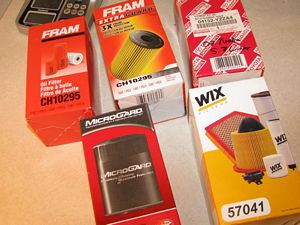|
By accessing/using The Crittenden Automotive Library/CarsAndRacingStuff.com, you signify your agreement with the Terms of Use on our Legal Information page. Our Privacy Policy is also available there. |

The Evolution of Oil Filters
|
|---|
|
|
The Evolution of Oil Filters
Tom Blackman
March 14, 2012
Oil filters seem like a pretty straight-forward concept: a simple filter that screws onto or drops into a car’s engine in order to strain contaminants out of engine oil and keep lubrication flowing smoothly. What seems like an obvious idea to us now is actually a fairly well-honed design that has gone through several changes over the course of its history until arriving in its modern incarnation.
In the beginning, there was… nothing at all
Early automobiles actually had no oil filtration whatsoever. Initially, what few cars that were on the road relied on frequent fluid changes to remove dirt, metal filings and other debris that accumulated in oil after as few as 500 miles. Gradually, engine lubrication began to require higher pressure oil pumps – pumps that could easily be damaged by random grit and other particles lurking in a motor. It was around 1920 that engine designers began to experiment with using primitive filters to help keep oil pumps from clogging, with options ranging from wire mesh to steel wool installed just before a pump’s inlet.
The birth of the modern filter
It wasn’t until the Purolator oil filter hit the market in 1923 that the prototype for the modern filter was born. The unit was a bypass design, with most of the engine oil passing straight through the filter while a small percentage was diverted through a series of perforated, cloth-covered plates. It would be more than two decades before the bypass design would be largely replaced by “full flow” filters, which were able to strain the entire volume of oil that was fed through them.
Full flow filters also brought with them advances in filtering media, with new fabrics, cotton materials and paper eventually being introduced into the equation. These types of filters were disposable by design – once their filtration media had been clogged with dirt and debris, they had to be removed and replaced. In order to facilitate replacement, spin-on filters were introduced in the mid-1950s, and over time they largely displaced drop-in cartridge filters in most automotive applications.
Today’s oil filters
Most oil filters today employ a paper filtration media inside a metal canister, and echo the full flow design from nearly 60 years ago. It is still possible to purchase drop-in and bypass filters, but the latter are usually only found in more commercial applications, such as with diesel engines (although cartridge-type
oil filters for the 2007+ Toyota Tundra are a notable exception). Filtration media can also vary, with some manufacturers using synthetic fibers while others use compressed cotton designs, fine metal mesh or fiberglass. The cheapest filters employ a cellulose filter media.
One thing hasn’t changed, however – it is still important to regularly change your engine’s oil filter in order to prevent sludge buildup and poor oil cleaning due to clogged filter elements.
About the Author: Tom Blackman runs Olathe Toyota Parts Center, one of the largest online OEM Toyota Parts stores on the web.


















